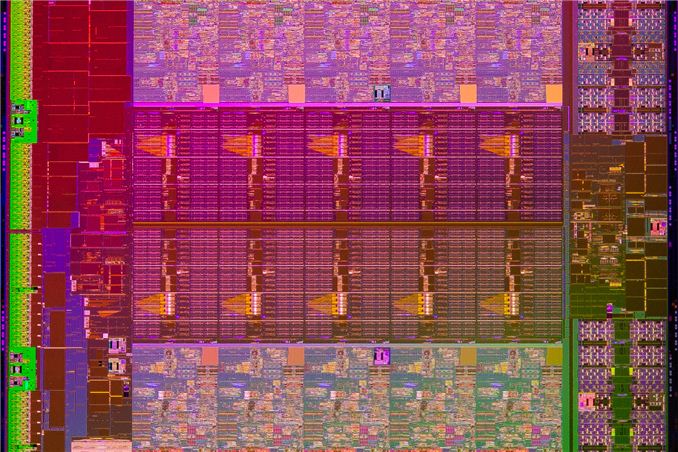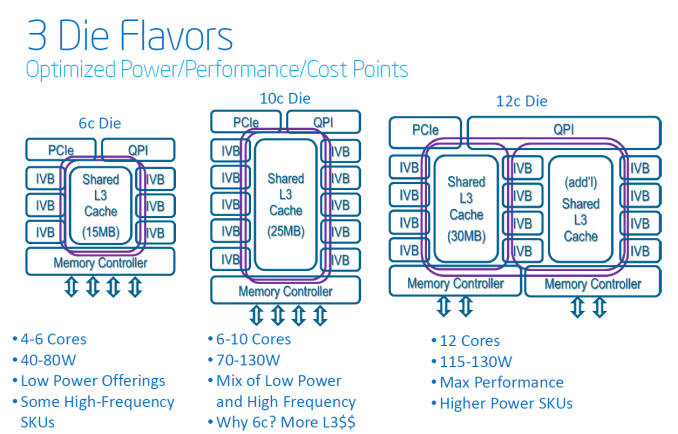Intel's Xeon E5-2600 V2: 12-core Ivy Bridge EP for Servers
by Johan De Gelas on September 17, 2013 12:00 AM EST
The core architecture inside the latest Xeon is typically a step behind what you find inside the latest desktop and notebook chips. A longer and more thorough validation is one reason, but there is more. The high-end model of the Xeon E5-2600 V2 or "Ivy Bridge EP" is, aside from the core architecture, completely different from the Ivy-bridge "i7 \-3xxx" that was launched in the spring of last year. With up to twelve cores, two integrated memory controllers, no GPU and 30MB L3 cache, it is the big brother of the recently reviewed Ivy-bridge E (Core i7-4960X). Intel has three die flavors of the Ivy-bridge EP:
The first one is the one with the lowest core count (4/6 cores), which is found in SKUs targeted at the workstation and enthusiast market (high frequencies) or low power SKUs; this is the core being used in the enthusiast Ivy Bridge-E processors. The second one is targeted at the typical server environment with higher core counts (6 to 10 cores) and a larger L3 cache (25MB). The third and last one is the high performance HPC and server die, with 12 cores, two memory controllers for lower memory latency, and 30MB of L3 cache.
The cool thing about the newest Xeon E5 processors is that they run on the same Romley EP platform as LGA-2011 chips. This should save the OEMs a lot of time and money, and hopefully these savings will trickled down to the customers. Let's see how Intel's latest server update performs, and if it manages to impress more than the enthusiast Ivy Bridge-E.











70 Comments
View All Comments
mczak - Tuesday, September 17, 2013 - link
Yes that's surprising indeed. I wonder how large the difference in die size is (though the reason for two dies might have more to do with power draw).zepi - Tuesday, September 17, 2013 - link
How about adding turbo frequencies to sku-comparison tables? That'd make comparison of the sku's a bit easier as that is sometimes more repsentative figure depending on the load that these babies are run.JarredWalton - Tuesday, September 17, 2013 - link
I added Turbo speeds to all SKUs as well as linking the product names to the various detail pages at AMD/Intel. Hope that helps! (And there were a few clock speed errors before that are now corrected.)zepi - Wednesday, September 18, 2013 - link
Appreciated!zepi - Wednesday, September 18, 2013 - link
For most server buyers things are not this simple, but for armchair sysadmins this might do:http://cornflake.softcon.fi/export/ivyexeon.png
ShieTar - Tuesday, September 17, 2013 - link
"Once we run up to 48 threads, the new Xeon can outperform its predecessor by a wide margin of ~35%. It is interesting to compare this with the Core i7-4960x results , which is the same die as the "budget" Xeon E5s (15MB L3 cache dies). The six-core chip at 3.6GHz scores 12.08."What I find most interesting here is that the Xeon manages to show a factor 23 between multi-threaded and single-threaded performance, a very good scaling for a 24-thread CPU. The 4960X only manages a factor of 7 with its 12 threads. So it is not merely a question of "cores over clock speed", but rather hyperthreading seems to not work very well on the consumer CPUs in the case of Cinebench. The same seems to be true for the Sandy Bridge and Haswell models as well.
Do you know why this is? Is hyperthreading implemented differently for the Xeons? Or is it caused by the different OS used (Windows 2008 vs Windows 7/8)?
JlHADJOE - Tuesday, September 17, 2013 - link
^ That's very interesting. Made me look over the Xeon results and yes, they do appear to be getting close to a 100% increase in performance for each thread added.psyq321 - Tuesday, September 17, 2013 - link
Hyperthreading is the same.However, HCC version of IvyTown has two separate memory controllers, more features enabled (direct cache access, different prefetchers etc.). So it might scale better.
I am achieving 1.41x speed-up with dual Xeon 2697 v2 setup, compared to my old dual Xeon 2687W setup. This is so close to the "ideal" 1.5x scaling that it is pretty amazing. And, 2687w was running on a slightly higher clock in all-core turbo.
So, I must say I am very happy with the IvyTown upgrade.
garadante - Tuesday, September 17, 2013 - link
It's not 24 threads, it's 48 threads for that scaling. 2x physical CPUs with 12 cores each, for 24 physical cores and a total of 48 logical cores.Kevin G - Tuesday, September 17, 2013 - link
Actually if you run the numbers, the scaling factor from 1 to 48 threads is actually 21.9. I'm curious what the result would have been with Hyperthreading disabled as that can actually decrease performance in some instances.